#hordak meta
Explore tagged Tumblr posts
Text
Let me explain why I like Hordak as a character
For me, there is always gonna by a Big Bag worse than him, doesn't excuse his actions but makes him struggle, only exception was 200x Hordak, but because the show was cancelled and they didn't go beyond the initial idea of him, his backsatory was brushed and he was mostly a two dimentional villain, and not even mentioning the DC comics which bastardized him deeply.
He ins't a redeemable character the moment he helps or joins the protagonists (be He-Man, She-Ra, the Masters, whatever who is helping in the plot), I knew that about him from the very beginning and that is the type of complexity I like about him; he is actually The Atoner and in several comics and even classic eps he has shown qualities of such. Meanwhile, Horde Prime or Anillis Kur, his older brother, is always behind his back, and he fears him and respect him, but every time he fails, Prime mocks him and threats him.
As well, in one of the most emblematic classic comics "Masters of the Universe Star Comics issue No. 11" from 1987, the idea of Hordak losing his memory (and with it his Horde conditioning) and slowly becoming an Atoner was alredy there:





But then he is manipulated magically by Shadow Weaver (insteresting concept, just how she did with Adora for years) and he returns to his way due to both the conditioning and his memories returning too, but he still has a choice of his own in the end.
The final point is Adora/She-Ra.
She is always involved in his plan in some way, be stoping him or him wanting her back because even in the classics, he raised her. Maybe not in the 2018 show, but even briefly there were several parallels between both. She is important for him be good or bad. I have no idea how to explain this further, but they understand each other, Adora as She-Ra mocks him in Flowers for Hordak and he immediately agrees to helps the rebels if they take Perfuma away, he abandons a battle he was winning after She-Ra helps him in Into the Dark Dimention. And involving Adora, he praised her from the very beginning even when he hasn't to because she was magically manipulated by Shadow Weaver, and until the very end his tunnel vision is the idea to get her back.
"But he kidnaped her as a baby!" a terrible thing indeed, but the Universe of MOTU isn't a peaceful one, because when this happened, the Sorceress erased the memories of Adora from the Eterians, even as a show explanation, there was apparently no further investigation about her, and years later Orko and Duncan kept the secret of He-Man's identity being Randor's son when he had been in more near death experiences that we can count, that is also horrible. And I can tell you isn't the worst thing a villain has ever done before, just ask Skeletor, or even Zodac.
But the basis is, the idea of joining or even help reluctantly the heroes, be for or against his own ideals is there, it exist as a concept for him, meanwhile when we are faced with Prime's ideologies and way of ruling, it isn't. In some way Hordak as a character adapts to the situation but also understand the other side of the coin, he express reluctancy, he has deep flaws due to his arrogance and he fails because of this, and he also express a choice of his own idependently of Prime, could you imagine what would happen if Prime finds out about him allowing the Rebellion to go unscratched because he felt he owed one to She-Ra?
And every time he is in some type of trouble, She-Ra helps him somehow because is very likely she understand this about him.
#Hordak#motu#masters of the universe#mypost#motu meta#shera#shera princess of power#she-ra#she ra hordak#hordak meta#adora#princess adora
13 notes
·
View notes
Text
more spop world building notes
i was talking with an irl friend about my brightmoon head canons and mentioned to them how odd it was that the boats in spop don't seem to sit in the water, as can be seen from this screenshot of sea worthy:
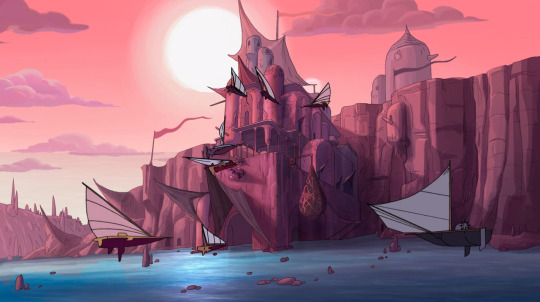
they also float in the air sometimes i guess.
example of them in the water:
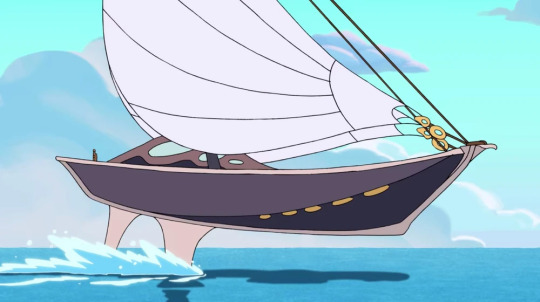
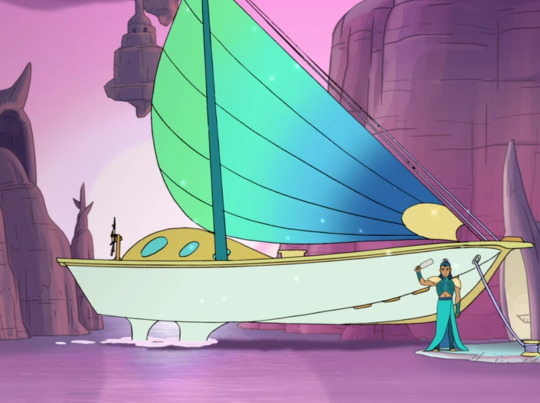

my friend noted that the fins look like hydrofoils , something i hadn't known about. theyre basically fins that go on the bottom of a boat and, qutoe from the wiki--
"As a hydrofoil craft gains speed, the hydrofoils lift the boat's hull out of the water, decreasing drag and allowing greater speeds."
real hydrofoils look like this:



the resemblance is even better with hydrofoil boards.

real hydrofoils have structures that go under the water in order to give the boat/board the lift to be able to rise up like this
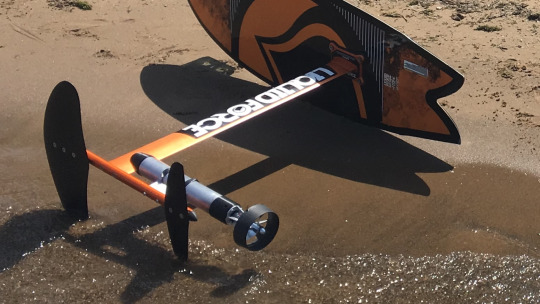

but what if the same effect could be achieved a different way?
we know that there's a stark difference in technology between the horde and the rest of etheria, but Horde navel vessels also appear to float just over the surface of the water despite looking much heavier than the other etherian ships we see.
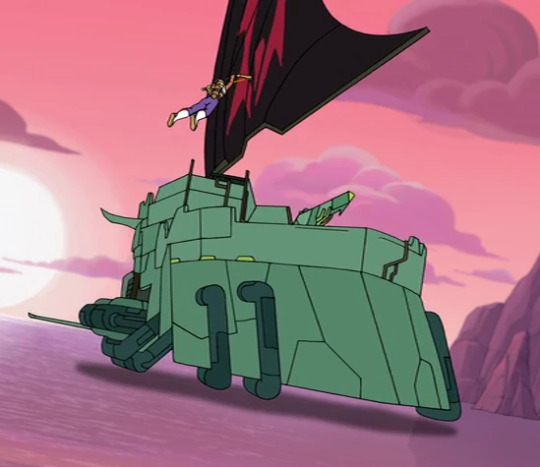
we also know they have other floating land vehicles like the skiffs.

much of their other vehicle technology has a scorpion aesthetic, as it was adopted or stolen from scorpias former kingdom. examples:

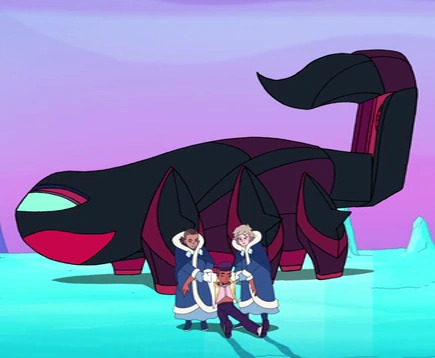
we also know that first one's technology combined magic with regular technology, and entrapta seems to be the first person to have been able to reinvent this kind of tech during the events of the show.
We also know that the galactic horde doesn't use magic in its technology at all, as its a major plot point in season 5.
other people have made theories that i agree with, (but don't feel like trying to dig up their posts) that when hordak arrived on etheria, he did so at a time when anti-princess sentiment was already high and was adopted into an existing conflict because he brought with him stronger technology that could even the playing field with people with magical powers. he then would joined with the scorpion nation in this effort in some way-- whether it was mutually beneficial or not.
this is the image of the scorpion nation being taken over by the horde that light spinner showed micah as a child to convince him to help her grow her own magical abilities
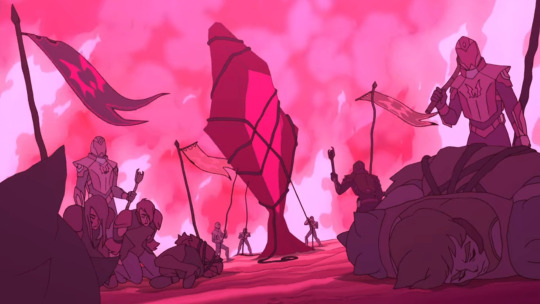
it should be noted that light spinner/shadow weaver was at this time a powerful sorceress in illusory magics and is a villian well known for manipulating children in her care (adora, catra, micah). The scorpion kingdom take over could have happened like this or been more of a mutual endeavor and this is just what she chose to show micah because she knew it would compel him to action. Evidence could point either way. Scorpia is the only living scorpion person we ever see in the show, but she's also been treated well (has her own room with a picture of her parents with her on display and a closet full of dresses) and been given status beyond her abilities in the horde. she's supposed to be a force captain in season one, before even catra is made one, and yet when she is left in charge of a crew of soldiers its played for laughs, as if she's never had to do that before in a meaningful way. at least to me, speaks to there having been an alliance between the growing Horde and the scorpion kingdom at least at some point, and maybe a promise to take care of a young princess that was honored.
the textual evidence in support of hordak bringing advanced tech to an old conflict is scorpia mentioning before the prom that the other princesses didn't like her kingdom even before the war, the face that the horde cadets grew up being fed anti-princess propaganda despite the horde harboring a known princess in a position of authority, and the tech that the horde has. As i said before some of it has a scorpion motif like it came from the scorpion kingdom, but some of it does look like what we see of galactic horde tech, notably hordaks lasers and the green forcefield prison cells present in both hordes.
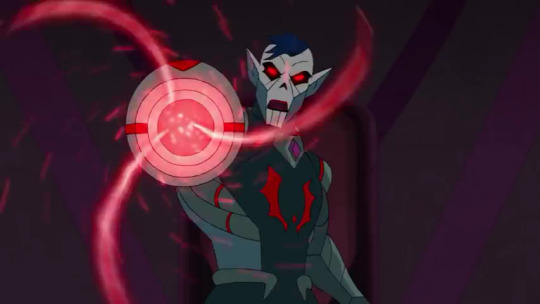
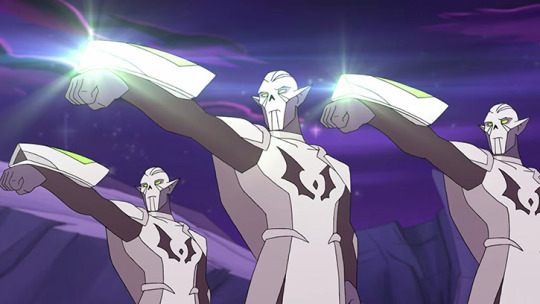

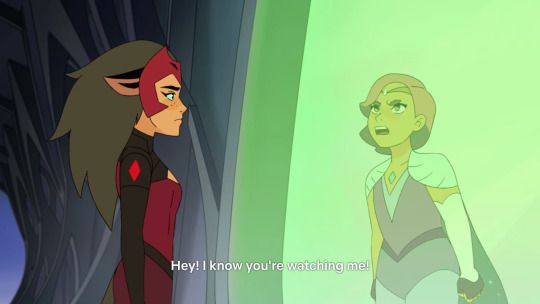
we also know that hordak himself is an engineer, having made many technologies presumably by himself-- such armor to hide and manage his medical condition, something he did not want other people to know about. So its my opinion that all of the tech we seen in the etherian horde is an amalgamation of scorpion tech, galactic horde tech adapted by hordak as well as new designs he invented. none of which use magic before entrapta joins the horde.
so what is my point? well, the other etherian kingdoms other than dryl dont seem to use any modern tech at all, at least at the structural level. like bow and his parents have a data pads they can call each other with, but much of the way people are living in etheria looks almost medieval. the princesses dont seem to have any ground vehicles at all for example.
and yet both sides have floating boats.
one could say the princesses boats are magical while the horde boats use some kind of magnets or some other floating technology we don't have.
OR
you know what they do both have?
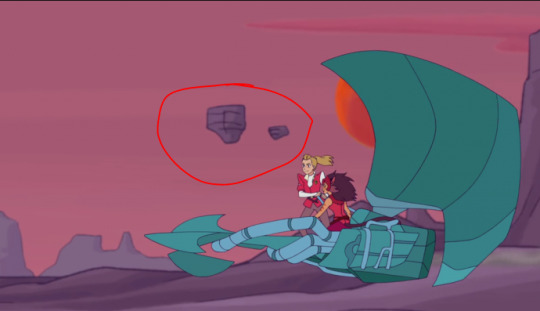

FLOATING ROCKS
so all of this to say...
what if they put rocks in the boat and it make it go up instead of down????
#and this is a technology that predates the horde which is why they both have it#but simple enough they dont need the secrets of first ones tech to do it#spop#shera#rambling#scorpia meta#hordak meta#spop meta#thoughts#sorry#this went on for way too long lol#i had a bit about hordak inventing the internet#i left it out cause its too long as it is but theres not much more to it than that#i just think it was him
135 notes
·
View notes
Text
"Do It" (Destiny Part 2)
When you interact with a lot of similar media, you tend to notice patterns and recurring tropes. Most notably in this example is the final season darkest hour.
Typically, when a series wants to ensure that the stakes are higher for its final arc, it will end the previous in a very dark place. Avatar: The Last Airbender does this, and I just covered The Owl House doing a very similar thing.
But She-Ra has a lot more to it than just the singular convention. This is an incredibly cerebral series with a ton of moving parts. So, for the season four finale, I would like to examine a few of them, and what they do for the story.
Let me explain.
SPOILERS AHEAD: (She-Ra and the Princesses of Power, Marvel’s Cloak and Dagger, A Christmas Carol)

Context is important, and stories have an understated ability to draw together disparate elements into a cohesive entity through a consistent theme.
Here, that is twofold. The series as a whole has been about the cycle of abuse as portrayed through tragedy, specifically in its antonymic relationship with genuine love. But Destiny Part 2 zeroes in on the chronological geography of this. As in, there is a distinct sense of time in this episode, and a discussion of the past and future and their impact on the present.
Everything in this episode revolves around these two ideas, and so everything must be analysed through those lenses.

Starting with the runestones, which are an idea original to the 2018 reboot.
“It’s like…”
“…connection.”

Throughout this season, we have seen the princesses glow when they achieve camaraderie, and that glow is near identical to that of the planet balancing itself. Near identical. The runestones are shown to be more powerful than regular camaraderie.
We don’t actually know the origins of the Runestones, with the exception of them being native to Etheria. The Legend of the Fire Princess graphic novel has one in it that was created by the first ones, which implies that the others were not. But I am here to talk about the main series. (If you want me to discuss the book or any other supplemental media, my ask box is open).
As such, I find it important that the power of the Runestones, much like that of She-Ra, predates the First Ones, which means that it was not theirs to use.

In my previous post about She-Ra, I commented on the First Ones as colonialists, and this adds to that symbolism.
The First Ones co-opted something that was, by all accounts, sacred to the people of Etheria, or at least of significant cultural value. It was repurposed into a weapon that would, as a side effect, wipe out the planet. Cruel and uncaring. The First Ones viewed Etheria as a tool that could be cast aside when it was no longer of use, a worthy sacrifice.
In terms of our themes, this is most definitely abusive behavior, and that continues into the cyclical nature of that abuse.
I have also discussed how it doesn’t matter if the First Ones were the aggressors in their war or not. If the First Ones were under siege, then they felt the only way to defend themselves was to inflict more suffering on bystanders. The abuse they received turned them into the villains of this season. But I think the most important moment for this part of the episode is this:

In her desperation and powerlessness, Glimmer tries to destroy the Runestone.
The anger at being used has been turned against the First Ones, but they are using the culture of the people they have colonized as a shield. To get to us, you need to stab yourself.
It’s forcibly disconnecting the people from the symbol of their culture, metaphorically and literally breaking their connection and leaving them weak and in a place of vulnerability.
This wasn’t even intentional. I don’t think the First Ones sat down and schemed about how, when this master plan goes off, there will be one princess who tries to break the runestones. It was a side effect. All of this was a side effect.
The main role of this was to destroy a different force entirely, Etheria was never part of the equation. The First Ones were fighting a war with someone else, and Etheria was just a sacrifice that could be made.

Glimmer is technically surrounded by the corpses of her enemies here. That is the context for her statement that "we are the good guys". Yes, they are robots, but Emily is sentient, so...
Abuse is fundamentally selfish. To the abuser, it isn’t about the victim, it’s about the anger and often pain that needs to go somewhere. It’s about the power and control. The victim was just there. My feelings matter, my heart, my obsession, my anguish. You are a convenient scapegoat.
It is important to understand that this mindset is built on a misunderstanding.
There is a reason for it. Of course there is. Everyone has a reason for their behavior. That’s what the cycle of abuse is. You get so wrapped up in your own mind that other people stop existing, and you are left with empty shells around yourself. But having a reason does not make you right.
There are real people around the abuser and the abused. She-Ra is a series about those real people, hence why it is so human in almost every character. It is about the real people who are hurt by someone else’s drama, the real people who get burned by being too close, the real people who get caught in the crossfire.
The Runestones are symbolic of those real people en masse. Used as pawns, corrupted, and destroyed.
In that sense, they also relate to the episode theme of time. They are monuments of a distant past and a history even greater.

At the risk of oversimplification, Runestones in the real world are a Scandinavian concept that emerged before the Viking age but gained traction during it. The vast majority were dedicated to the fallen, but a fair few discussed everyday life and stand as monuments.
They also look nothing like those in She-Ra.
In She-Ra, the Runestones are aesthetically just gems and crystals that are big and look cool. So, why go with the name?

First and most obviously, it sounds magical. Runes sound magical and as any architect will tell you, a large part of any creation is the emotions it inspires. If you want a story about magic, saying “this is a glowing crystal called a runestone” is an easy way to do that.
Although, that does bring up an interesting meta question of why there is magic in this story? As in, what does it do for the themes?
I plan on delving into this question in more detail in a later post, so you have that to look forward to.
For the moment, however, the She-Ra has made a point of connecting magic to nature, and so the name “rune-stone” entangles magic to the ground itself. It is the bedrock of these civilizations.
The other reading is that the stones themselves serve as runes, which are in turn a form of written language and communication. They are the words of people long gone, although crucially, their descendants are still there.

This is how culture exists in a very real sense. Not merely through written words, but through the language and communication itself. Mythology and religion, history and philosophy. Word of mouth and art. Culture is not a static thing of aesthetics but a dynamic manifestation of shared ideas, and sometimes it dies out, but usually it just continues and evolves into new forms. It is everything that has come before and every word that is spoken.
I mean that literally. Every single word has a history and evolution that makes up its current form. The word "Silhouette" comes from a French who didn't like to spend money. Language is the manifestation of history and how it informs the present day. It’s part of everyday life, it is context.
The Runestones are that language as a physical manifestation that literally grants power, and the First Ones use them to destroy people. In this way, what the First Ones did was cultural appropriation, and I don't think my opinion is unpopular that this is, in fact, bad.

Moving on to Light Hope.
“Mara. Mara would not want me to… Mara was a traitor. She turned against her people.”
We have seen two sides of Light Hope. The one who Mara befriended, and the one whom has manipulated her way through half of the series. The weapon of war who couldn’t escape. The cycle of abuse come full circle.
We have seen Light Hope get humanised, and then cast that away. But as best we could tell, it was the system itself that overrode her free will.
This line, however, muddies the waters, because it reminds me of another in the same episode.

“People have hurt you, haven’t they? They didn’t believe in you. They didn’t trust you. Didn’t need you. Left you.”
Of all the people to draw a connection to, Light Hope’s dismissal of Mara is strangely reminiscent of Catra’s antagonism towards Adora.
The cycle of abuse hasn’t just happened before on a grand scale with the She-Ras themselves being destined for tragedy, but this specific plot has happened before, and look how it ended up.
Catra has spent the entire story addicted to power like a safety net. She craves being the highest ranked one in the room because it’s safer, but there isn’t much room at the top of the pyramid. You end up alone, and isolated, and with further to fall.
Catra has been trying to claim power like Shadow Weaver taught her, but has ended up like Light Hope. Alone in her tower, scheming, reminiscing, caught up in memory and spite.

This is a warning to Catra. Most obviously, change your ways. But just to be safe, don’t ever cut your hair and don’t ever start wearing white.
Once again linking back to the themes. The cyclical nature of this series is best exemplified by the threat of another season. This is a story that wants to end, to be free, but it keeps coming back to a song and dance.
I mean this as a compliment. This is the only series that makes me fear another season, but stay glued to my seat as I watch and love every moment. The screen protects me from what is happening inside, and the fact this is a story means that I can stop at any time. That isn’t a luxury the characters are given.
The aim of the series is to end.
And it will, that’s the key thing here. Everything ends. The cycle of abuse is not a true circle but a spiral that winds in on itself until disaster.

Light Hope and Mara are the emblems of a previous cycle. Their story ended in tragedy they couldn’t avert and that left naught but shattered people and places in its wake. Light Hope was Catra, she was someone who was happy. But now she is an instrument of the system that drove them apart, unable to understand or take comfort from Adora until the end, begging for Adora to "do it", begging for death. This is who Catra will be.
Don’t believe me? There is only one other person who uses the words “do it” in this episode. Can you guess who that is?

“What are you waiting for? Do it. Looks like we're both alone, Sparkles.”
There is, however one majour difference between the old story and the new. This rendition isn’t over yet.

I haven’t seen nearly as many Marvel films and TV series as I should have. I saw Infinity War and End Game, I saw Thor: Ragnarok, and I watched Moon Knight, but other than that, I mostly never cared for the series as a whole. I didn’t dislike the films, I just never cared that much.
Which is honestly weird, because I read comics on the regular, and got into comics through Marvel. I started with a Spiderman one shot in the Clone saga, and while I wouldn’t call myself a comic nerd by any stretch of the imagination, I was enough in the spaces to know who Jeff the Land Shark was before Marvel Rivals was a thing.
The reason I bring this up is to recommend a series I left out of the above list, Joe Pokaski’s Cloak and Dagger, which ran from 2018 to 2019.

I had read a few comics featuring the eponymous heroes before I saw the series, so I knew vaguely who these people were, but this was one of those series that got me at just the right time to leave a lasting mark on my psyche.
Most notably, this is the place from which I get the phrase “There’s always a point of no return. It’s called the end.” But there’s a little more to it.
The premise of this series is that Luisiana is always saved by two kids, and that one of them will always die in the process. Tyrone and Tandy (Cloak and Dagger respectively) spend the series trying to find a way to escape this cyclical tragedy.
The season one finale will always break me, because we see the moment when Tandy comes the closest to being the one to die, and it’s not in an overly violent fashion, it’s in a phone call.

The two are trapped in a surreal, timeless landscape, and Tandy is presented with a phone using which she can call her deceased father a moment before he dies. She picks up the phone, has a brief conversation, and then the line goes dead. She picks up the phone again and has the same conversation. Again, and again, and again. Just one moment.
Tyrone asks her to leave, she refuses, so he asks her how long she has been there, a question to which she has no clear answer.
If Tyrone hadn’t rescued her, Tandy would have as good as died there and then. Lost to a memory. Lost to the trauma of losing her father playing back to her over and over again.
Cloak and Dagger are played by Aubrey Joseph and Olivia Holt, and while Holt's performance as Tandy in this scene is the showstopper, it would be remiss of me to not mention Joseph's portrayal of Tyrone as he realises what is happening and tries to stop it.
There is always a moment of no return. It’s called the end.
You lose when all hope is lost. You lose when you give up. You lose when you let everything consume you. You lose when you stop trying to escape.
Cloak and Dagger keep getting told that one must live and one must die, and their response is “how about no?”.

Light Hope lost. She became the monster that created her. But that cycle ain’t done for the here and now, Adora and Catra can fix this.
This actually moves really nicely into the third and final element of this episode that I would like to discuss. The title.

Destiny and fate are funny things, aren’t they? They don’t actually mean anything. Not tangibly, anyway. Yes, yes, your fate and your future are one and the same. But that isn’t a fair metric, is it?
Is fate inescapable? Was I fated from birth to write this post? Was my future laid out for me? Or does it work slightly differently?
I am partial to the dichotomy between fate and free will. That being, a person with free will has the autonomy to make their own way in the world and decide their own fate, whereas everyone else is just pulled along by the strings of time. I think this is sweet.
In practice, I have found one way of writing destiny that I like. Nature.

For the record, I am including nurture within this. A person’s nature is just who they are, their history and goals, their fears and hopes.
Specifically, life experiences make up a person. If I find an arachnophobe and I give them a spider, I can be pretty sure how they will react. That is your destiny. It is the path set in front of you by yourself. There is freedom to wiggle within that, but everyone has a set of key components that make up their personality, and in the right circumstances, this can be manipulated.
I could go for the obvious here and talk about how God Of War: Ragnarök leverages this to talk about trauma. I could. It would certainly fit with She-Ra’s discussion of that concept through the cycle of abuse.
But instead, I am going to recommend you the video by Overly Sarcastic Productions (@comicaurora) about that very topic (link) and go further into the past with Charles’ Dickens’ A Christmas Carrol, or more photogenically, the Muppets film of the same name.

“Are these the shadows of things that will be? Or are they the shadows of things that may be only?”
A Christmas Carrol delves into themes of redemption and capitalism, and I will die on the hill that Charles Dickens had a wicked and very dark sense of humour that was brought about by the time in which he was writing. But for the purpose of this post, the book wields the future like a threat.
“Your chains are forged by what you say and do.
So have your fun, when life is done, a nightmare waits for you.”
In A Christmas Carrol, fate is just consequence. Cause and effect. The book is about three ghosts appearing to a miserable old man who thinks he is alone and unimpeachable and showing him multiple occasions when his life was directly impacted by others, for better and for worse, and the effect that his life is having on others.
It opens with a warning from the ghost of Scrooge’s business partner/partners. Cause: Greed. Effect: Chains. Easy one two punch.

It is crucial to me that when Scrooge finds his grave and asks if the future can be changed, the spirit gives no response. It doesn’t give him comfort, but it also doesn’t tell him his future is set. You can try and change your fate. Go for it. If you don’t you will end up here. Alone even in death, but still buried like every other man. There are no coins in your coffin, just memories.
The point of no return is called the end. You decide what that will end up being.

Adora and Catra have been thrust into this story by their natures, and they have been positioned in such a way that can only lead to destruction.
It was in Catra’s nature to take Adora leaving as badly as she did, because she has grown up being told that affection is exclusive and that a person can only care about one other person. She has been taught love in an incredibly dysfunctional way, and she is just a traumatised child, but she’s a traumatised child who is actively wrecking other people’s lives.

Similarly, Adora is a hero in the most self-destructive way possible. She has to save everyone, has to destroy herself for everyone else’s happiness. She is a pawn in a war and she will burn herself to the ground to feel any kind of warmth and it will kill her.
It is these two’s destinies which clash. The cycle of abuse is a spiral that leads to destruction. The tragedy is tragic. So, what do?
To change your fate, you make the decision to change your nature. An arachnophobe can overcome their fear, Scrooge could become a charitable man, Adora and Catra can escape.
If we lean back into the path metaphor. Your nature is a road that itself is moving towards a destiny. If you try and get off it, you will fall over. But you can reach the edge. You can break free. You can start moving in a different direction.
It is always possible to change.

Before I finish up, I want to discuss Horde Prime’s introduction, because he is fantastically incurious in a way that leans into what I have been saying about the inherent self-centredness of abuse.
“You have forgotten who you are. You truly think you are worthy to stand beside me, could be equal to me?”
If Horde Prime was reading Hordak’s mind, he would have seen the portal and the source of the energy reading. He would have been curious as to its use. But no, he projected.
It didn’t matter what Hordak did, it would never have been enough. The fact that he gave himself a name was sufficient to warrant animosity. Prime didn’t need a reason, he needed an excuse to show off his power to Glimmer, but also to himself.
Side note here, Horde prime is played by Keston John, who also plays Darius in The Owl House, and has a voice that can melt butter.
I say this because he turns that off like a switch as he shouts down the powerless Hordak. That grace and smoothness is gone for a horrible growl.

This tiny little gesture as Prime draws back his hand before he strikes. He's deliberately offering Hordak grace and kindness, deliberately making it clear that they were an option and he chose violence. He is giving hope so that it stings even more when he takes it away.
Which presents a question: Is Horde Prime actually put together? Is the snarling monster a tool that he uses? Or is it the real man? Does the distinction matter?
Prime has to be told about the weapon. He doesn’t think for himself, he just coasts off everyone else’s misery.
This man is a physical threat, sure. We have seen that in previous episodes. But here he establishes himself as a thematic force in the narrative. He is an abuser, he is a manipulator, he is selfish.
Horde Prime is terrifying.

Final Thoughts
I had meditations about Arcane and Shakespeare in this that I had to cut because this is one of the longest posts I have ever written.
I want to stress that She-Ra as a series didn’t go places. It didn’t cover new ground as it progressed. Episode two of series one shows a home destroyed by the trauma of a war and the psychological damage that the cycle of abuse can do to a person. She-Ra started here, it just got blunter as the characters got more and more wrapped up in their own heads. Eventually, the show literally wrote its themes on the walls.
This is a tragedy desperately trying to happen. That’s what’s so compelling about the final season yet to come. The character’s have one last moment to get their arses off that road to the end of the world.
Last chance. Last stop. The point of no return is called the end.
Next week we are diving straight into season five, so stick around if that interests you. Let’s do this thing!
Previous - Next
#rants#literary analysis#literature analysis#what's so special about...?#character analysis#she ra and the princesses of power#spop#she ra#spop adora#she ra spop#spop catra#catra#adora#spop analysis#meta#long post#spop hordak#spop horde prime#horde prime#cloak and dagger#marvels cloak and dagger#a christmas carol#a muppet christmas carol#spop light hope#light hope#spop mara
31 notes
·
View notes
Text
sooo wrong hordak
i often see lots about him being a pointless character who could open doors at the time and ended up along for the ride - and don't get me wrong -

they needed to be opening some doors forsure.
but i see more to him than that. it's even in his (lack of a) name. so much mirroring in this show done in the traditional flip across the vertical axis, but to me, i see wrong hordak as kinda swapping across the horizontal. you take the concept of hordak, and flip it upside down. maybe it's even a funhouse mirror or some shit, cause idk, but i can kiiiinda see it.
dude's been exposed to sooo many things hordak never was, and soo sooo quickly, too.

-cut off from the hive mind --goofy ass etherians in bright fun fckin clothing treating him as one of them for no goddamn reason ---being fed undeniable proof from prime's own logs that he's been lied to ----wanting to bring him down -----realizing he's already w the people he needs to be with to try n do that


how quick, how simple the turn around is for wrong hordak reads to me as something of significance. there's so much in this show that challenges indoctrinated thought - which exists in many forms, but i can't help seeing wrong hordak as a juxtaposition to hordak by employing what seem like such simple, laughable differences in their experience of being separated from horde prime, in order to show how little it sometimes takes to really pull back the curtain for someone so they suddenly see what they couldn't before, vs how long it can take for someone to even get a glimpse of it when that curtain never moves, unless they find a way to move it on their own.
hordak can thank entrapta for that one. and tbh this is just one of a few posts i've been making cause i felt like i wanted to say some of it before i made the post i really wanna about hordak and entrapta, but esp hordak, tbh. dude's been doin the big bad thing, but in all honesty, he's been playing a part as much as anyone else you could accuse that of; knowing nothing else; a perpetuated cycle, if you will.
dude wanted to break it. "there was even a time you wished i would not come for you..." but ended up pulled right back in. luckily, prime was dumb enough to put the person he had to have known brought hordak to that feeling- right in front of him. resulting in nothing more than prime issuing hordak the last command he ever would.
cause he ain't your brother, bitch. he's more than that.
and you don't understand what makes them strong. but hordak finally did. and he won't let it go.
<3
#spop#she ra#spop hordak#wrong hordak#spop horde prime#spop entrapta#spop meta#spop analysis#love is what makes them strong#in case it wasn't clear <3
35 notes
·
View notes
Note
Question 6 from the entrapdak question game? :))

Thank you for the ask! There are two terrible takes that to this day make me believe that some antis watched spop skipping every scene that had Hordak in it
Well, the first one is more of a crazy conspiracy theory, but I still wanna mention it - "Entrapdak is a pedo ship cause Entrapta was meant to be a teenager" and "her age was actually retconned so the writers could ship Entrapta with Hordak". I do wish that Entrapta's age was confirmed in the show itself, cause this aspect of her character did genuiely confused a lot of fans, but thinking that she was actually written as a minor but then was aged up just cause the writers wanted to make entrapdak less problematic?? Insane
The other take is "entrapdak bad because Hordak was manipulating Entrapta to work for him and was abusive towards her". And it used to be such a prevalent opinion in the main fandom too! I honestly think those people just hated Hordak sooo much (mainly for being a threat to Catra) that they were making shit up to make him even more evil and irredeemable so everyone would stop liking him or wishing him a happy ending. Many also loved Entrapta, but hated Hordak so much that they imagined he'd be a terrible partner to her and were insisting that she "deserved better" and was actually unhappy with him (some fake ass Entrapta fans imo) Like, lets dissect this take again. At first, as fellow Hordak fans always say, Hordak couldn't even manipulate himself out of a plastic bag. Plus there wasnt a single scene where Hordak manipulates Entrapta to do smth for him. It was Catra who made Entrapta side with the Horde and convinced her to work for them. Hordak didnt mind, but he also had no say in this. And when they became lab partners it was Entrapta who forced herself into Hordak's lab and in his life, she was the one always insisting on getting information and knowledge out of him, who insisted on working with him, bro just could not make her leave!
Many used to say Hordak was only using Entrapta for her skills (and also didnt care about her as a person, like hello?? have they seen s4 and 5?) when Hordak never made her do anything she wasnt intersted in - he didnt made Entrapta help him build the portal, she was already curious about portals! he didnt make her take care of him or build him a new set of armor, it was her gift! and he was never forcing Entrapta to stay by his side or be loyal to him or the Horde - she simply enjoyed working on this project and spending time with him. And when Hordak was told that she betrayed him he just... accepted it and never thought about revenge or punishment or anything like that. And he wasnt angry cause he lost a tool that could upgrade his tech or fix his problems, he was devastated because he lost his only friend. But you know who only saw Entrapta as a tool-
Then the abuse part - by that antis usually meant those two moments when he yelled at her/ cut her off while being in pain (and also brushed off Entrapta's hair). Like, yeah, Hordak has anger issues and he does scream a lot, and my boy should work on that, but such behaviour never made Entrapta feel distressed or afraid of him. She was either unbothered by Hordak's attempts at being scary and intimidating, or she was sad FOR him (and slightly dissapointed) - she never took his outbirsts as Hordak being genuinely mad at her, she knew smth was wrong with him, but it had nothing to do with her. He yells when he tries to imitate Prime and make ppl leave him alone, or when he's in so much pain he can't handle it and once again wants to be left alone (all because he himself doesnt feel safe around ppl T-T). Should he still apologize for snapping at Entrapta? Yeah. But is such behaviour abusive? I can be, but in case of Hordak? I dont think so
35 notes
·
View notes
Text
What do you do with a brainwashed army of cult survivors?
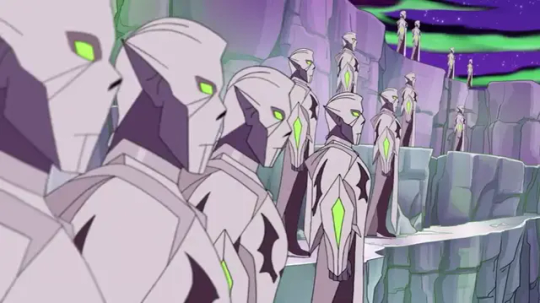
At the end of Heart Part 2, Etheria still has a population of thousands of Horde Prime’s clones. This is going to be, putting it mildly, a Problem for the Etherians. I don’t know if you��ve ever seen what happens to a cult follower when they are faced with conclusive evidence that their entire worldview was false, but you probably have some intuitive idea. Imagine if you said to a young-Earth creationist “Hey, here are multiple overlapping lines of evidence proving beyond reasonable doubt that life on Earth evolved over hundreds of millions of years,” or to a Scientologist, “Check out this evidence that L. Ron Hubbard was a fraudster who started a cult as a money-making racket!” You can probably guess that in each of those cases, the response is unlikely to be, “Goodness, I have been mistaken all my life! Thank you, kind friend, for relieving me of my false beliefs.”
As someone who’s left a cult, let me tell you, the clones are not all gonna react like Hordak or Wrong Hordak.
You might have heard of cognitive dissonance theory, but most people misuse the term, so I’ll quickly explain it. When humans encounter information which contradicts or disproves their deeply held beliefs, they experience psychological discomfort. This feeling sucks, and people will go to great lengths not to experience it. But when those beliefs are central to your identity and your place in the world, letting go of those beliefs also sucks, and people will go to even greater lengths not to do it. So they resolve the cognitive dissonance however they can. They might decide the person who gave them this information is an evil liar and lash out at them. They might find a way to convince themselves the information is in fact compatible with their beliefs after all, and then try not to think too hard about whatever mangled assemblage of the facts they have settled on, in case it falls apart under closer examination. They might modify their beliefs slightly to fit the facts ("Prime always said he would go away for a while before returning in triumph!"), and then maintain that this is what they thought all along.
As an aside, one of the landmark texts on cognitive dissonance theory is When Prophecy Fails, which tracks the actions of a doomsday cult after the world failed to end on their predicted date. Sure enough, the acolytes of this cult did not abandon their beliefs despite this pretty concrete evidence that they had been wrong. Instead, they started recruiting new followers as hard as possible. They tried to get social reinforcement for their beliefs (“This must be true—look how many people believe it!”) to help them cope with the empirical disconfirmation they’d just lived through. So yeah, this theory is highly applicable to cult behaviour. And Prime’s clones are quite definitely a cult.
So it’s fair to say that just because the Hive Mind is down and She-Ra has just kicked Prime’s ass into oblivion, the clones are not all gonna just accept that Prime is gone and his mission is over. Some of them are going to continue fighting, convinced that Prime is not really gone. Some will insist that their connection to the Hive Mind is still intact, and deliver messages as the word of Prime. At least one clone is going to claim to be the reincarnation of Prime himself, and begin recruiting followers. More likely, several clones will attempt this gambit, creating factions with names like The True Followers of Prime and The Glorious Servants of Prime. These factions will go to war with each other in service of their Prime (honourable, redeeming) against the enemy’s Prime (evil, destructive). As time goes on, these factions’ ideas about Prime’s teachings will diverge, providing new opportunities for conflict. If they’re allowed to go on long enough, probably some benign and progressive versions of Prime’s cult will emerge, teaching that Prime in fact existed to bring peace and freedom to the Universe, and that those warlike factions have strayed from the true path of Prime.
All of this gives the people in charge of Etheria a headache. Etheria doesn’t believe in retributive justice, and as brainwashed cult members, the clones have diminished responsibility for war crimes they committed while Prime was alive. So it’s fair to say they can’t kill them. But they also can’t just ship them all off to live unsupervised in a colony somewhere in case they radicalise each other and start another war. Sure, some of them will follow Wrong Hordak into accepting that Prime lied to them, and they will find meaning by travelling the universe, attempting to restore planets Prime destroyed. Some, like Hordak, will give themselves names and begin the agonising process of creating an identity for themselves outside of everything they ever thought was true. But what of the rest of them? They’re essentially adult children, ignorant of everything Prime did not want them to know. They also trigger PTSD flashbacks in a great many citizens of Etheria, who cannot look at them without remembering what they suffered under the Horde.
What do you do with that many brainwashed survivors? What does compassion and restorative justice demand? I don’t know if I’ll get around to writing this as a fic or not, so here’s the setup and you can let your imaginations take it where you like. I’m new to tumblr and to the spop fandom, so if you read this far I’d really appreciate a reblog. And if anyone else has already had similar ideas, I’d really like to read them.
228 notes
·
View notes
Text
This might not make any sense because I've only had 1.5 hours of sleep, but there's a pipeline between Hordak's imp functioning as the hivemind in the sense of "Horde Prime Knows All." The imp spies on the Horde in Etheria for Hordak the same way Horde Prime spies on the Horde using the himemind. Hordak drew from Horde Prime's example and Horde Prime saw him as a threat for doing so.
92 notes
·
View notes
Text


Imp lore while I'm collecting things
#imp#hordak#spop#shera#she ra#shane lynch#crew-ra#meta#i knew this was a popular fan theory but I didn't realize it was confirmed canon#sorry I am posting so much I will go away now
27 notes
·
View notes
Text

MASTERS OF THE UNIVERSE: REVOLUTION comic Issue No. 1 by Dark Horse Comics (available here)
Summary:
"Journey to the earliest days of one of the universe’s most consequential, and fraught, team ups in this first issue of the official four-part prequel to the Netflix streaming event. Hordak is an ambitious general, eager to make his mark; Skeletor is an aspiring mage, hungry for power. Joining forces, melding ancient Eternian magic with advanced Horde technology, could bring them all their evil hearts’ desire…but they’ll have to survive each other first."
I'm going to proudly admit that I've sacrificed hours of sleep writing this, sorry for the bad spelling.
Okay, Masters of the Universe Revolution prequel comics was released early past month (May 15th) and as a MOTU/She-Ra fan I just had to check on it after watching the last season. And oh boy, there is a lot to unpack here….
The story of this prequel arc is centered around Keldor's origin and life as Hordak's apprentice, very much like "The Secret Origin of Skeletor" from the Minicomics era (which you can find here in @emperorsfoot blog), which took a lot from the He-Man 200x show and comics. I would say this is a rightful continuity to what the 200x never did, but with a pitch of new plot material and new perspectives to add.
For once, the writers also took a focus in Hordak's mysterious backtory and point of view through the issue, now is not only Keldor who shows his perspective of the story but also Hordak has something to say; both are the protagonists, not only one of them, which also shows us a glimpse of their future relationship as apprentice-master.
Lets start.
The story begins with a tale told by an unknown figure, (whose identity is addressed in the next pages) about a big battle (the first balled in the Universe) between the forces of Zoar (our beloved Preternian God from which the Goddess' powers belong) and Ka, God who would be the representation of Serpos in this continuity (the deity of the Snakemen). As the tale says, both turned against each other... until Ha'vok arrived.



According to this unknown person, Ha'vok is a deity and power who brings balance between Zoar and Ka, but entered a type of... stagnacy over time. Now, who is the champion?
Now, the first scene of the issue, oh boy. I love when the Horde has a good intro.


The Horde has always been a favorite of mine, and the introduction of two new female characters (you know, because the writers can't use any of the female characters belonging to the She-Ra continuity due to copyright reasons) has put a smile on my face for real. These two characters were designed by Alex Gimenez, but he couldn't continue with the comic project unfortunately:

They are a cool new addition to the Horde team, and I am very happy to see the original Horde members around too.


We are in Anwat Gar... the Island which was already mentioned by the 200x show as a site with great technology, as well as in the Revelation prequel comics, showing us is the site where the Gar lived in this continuity.
The Horde is attacking the place for an unknown reason, and at some point is mentioned that magic is actually forbidden in that place, contrary to what is seem during Randor's rule in the present.
Meanwhile, where is Hordak?
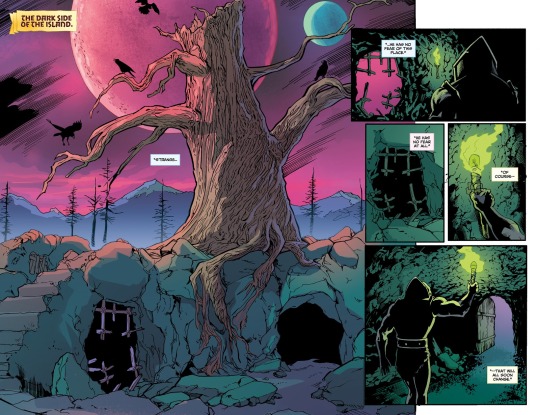
You see it right??! for old MOTU fans, this is the Fright Zone playset!

Apparently, Hordak has used the attack as a type of distraction to get to this place, he is looking for answers, and only magical entities can give it to him:
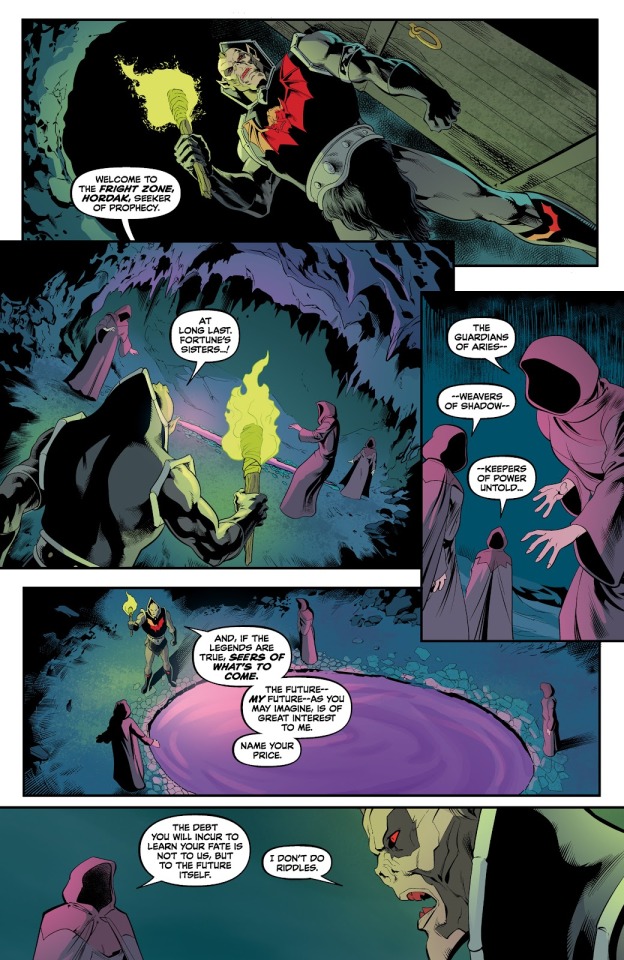
I want to take a moment to appreciate the call back to She-Ra's classic comics because these Fortune Sisters are a tribute to the 'Enchanted Sisters' who canonically ended up tricking Hordak in the classic comics:

Also, some dialogue of the scene:

Who the hell is Gaull?!
Soooo I had to go back to the He-Man character encyclopedia, remembering that Hordak's father was caller "Seferus-kur" also known as Horde Supreme, killed by Horde Prime (Anillis Kur) and Hordak (Hec-tor Kur), this info is ONLY in the MOTU 2008 bios and also to the 200x continuity (that is the story they wanted to use for the comics), so I guess they have choosen to retcon Hordak's origin story and also add a name for his father, because contrary to DC's interpretation, Prime is Hordak's older brother here:

Note to add, Revolution's continuity choose to go by a technological background for Hordak rather than magic, making the Horde a highly technological empire which despises magic.
More dialogue, Hordak's prompting to Eternia's ChatGPT


Man... the future will kick you in the ass.
Also, FINALLY the introduction to our second important protagonist in this issue...


Keldor's backstory is very similar to his 200x one, the only difference is that in this continuity he knows who his mother is, as if he had been raised by her rather than with Miro's. In fact, he was pushed to go and live with her by his father in the end. And surprise, she is a magic user, which was already pointed out as something forbidden in Anwat Gar, but Keldor doesn't care and uses his magic to attack the Horde invaders.
Saryn (Keldor's mother in 200x, here we don't have a name yet but I guess they will go with her original one) is the first magic teacher of Keldor, and she taught him for most of his young life, together with the magic history of Eternia, so we can already imagine who was narrating the story of Eternia's deities in the begining:
She taught him two things 1) we are made to defy and surpass our teachers 2) Keldor is destined to exceed Miro (Randor's and Keldor's father) at all cost and become a champion.
As well, she maintains a kind of telepathic connection with Keldor, where she constantly tells him he is destined to be a champion. But if she communicates with Keldor this way, where is she? apparently in some type of expedition:


Meanwhile Hordak has become frustrated by the Fortune Sister, who are trying to follow his indications, but going around the destiny of... someone else, who will accompany him through a parallel path:


"Grayskull's heir, yet unborn, will ground the ascendat bat, and in the fierce and final battle, Des-"
Screams internally... Hordak shut up and let the magic women speak.


Interesting thing, there seems to be a disagreement between some of the Fortune Sisters here, I wonder why?

*snorts* I really love this panel so much, Hordak is just so arrogant he thinks he would get it right away... man what if this was charged by some type of magic that would have killed you in an instant?!
Now we get to Anwat Gar again, where Keldor is trying to reach his mother while battling the Horde, meanwhile the citizens are more concerned about a magic user saving them than the whole Horde army around destroying the city, so we can say they have their priorities.
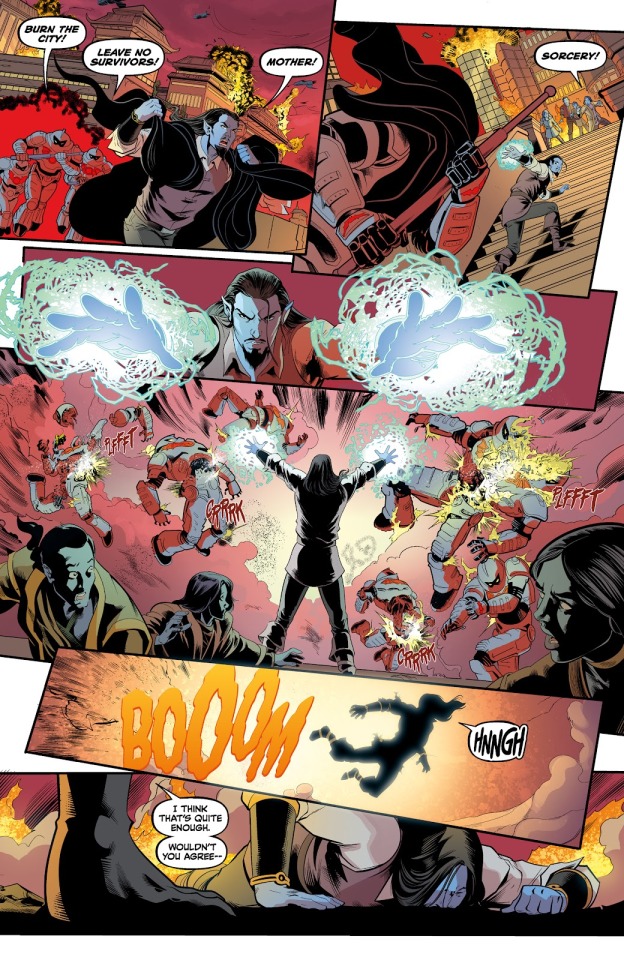
Finally Hordak arrives, helping a wounded Keldor and telling him it was all a distraction, as well Hordak tells him some interesting things:

"My name is Hordak, Supreme commander of the Horde fleet, Next in line to the Emperor's throne" hmmm...
Is important to highlight, is not Hordak who convinced Keldor to join the Horde, but his mother:


Finally, Keldor is recruited by Hordak to join the Horde, telling him they had uncovered a great power, and manipulating him (quite easily) to search for his rightful destiny.
Some things I liked about this issue:
The illustrations and art are ways better than most MOTU comics I've seem, even DC comics gets short in quality.
I liked the subtle call backs to the classic comics, the use of new characters, especially with the copyright issue, I believe the Fortune Sisters are going to reemplace Shadow Weaver, and the new Hordewomen are here to stay. We can see they cared for this story, especially with how much Lore they are trying to inplement here, blending most of the past continuities to create a new logic.
I liked that the Horde is a technological empire, just like the classic Filmation shows, and Hordak clrearly is the same arrogant and proud commander, still I can see he is more cunning and intelligent here, not the buffoon he was in the 80s, he is a good blend between his past continuities, including 2018. There is ambition in what he says, but his arrogance takes the worst of him.
If I have to point out what disappointed me the most... I do believe Keldor's introduction. He seems to be too young maybe, still focused in his mother's teaching and being seem as a rightful heir by Miro, his father. He is easily manipulated both by his mother (we don't know if she is good or bad yet) and by Hordak. he is desesperate to have his destiny and legacy.
I don't trust the Fortune sisters, or the only one of them who presented Hordak's with the Ha'vok staff, is evident she is going to be an antagonist in the future, and maybe she is Keldor's mother trying to led his son into a path for power using Hordak, which could be Keldor's undoing.
Thanks to @pennamesmith @lemaistrechat and @kuurankaiho for talking with me about this issue, is always good when there are more MOTU material to explore XD
#hordak#motu revolution#masters of the universe revolution#keldor#skeletor#masters of the universe#motur#motu rev#motu revelation#motu comics#dark horse comics#horde#evil horde#eternia#he-man#heman#he man motu#he man skeletor#he man keldor#revolution comics#mytext#mypost#motu meta
34 notes
·
View notes
Text
Entrapta and Hordak are in a b4b (barbie 4 barbie) relationship, sold separately as the Lab Partners Horde Sanctum Playset™. Each of them come with half of the portal as well as a workbench with a few tools and a special plastic companion creature (Entrapta comes with Emily and Hordak with Imp).
when both sets are together they can be fitted to form the whole portal but it cant light up without the Sword™ (sold separately either by itself or with a special bonus Catra line.)
Entrapta's hair is brushable and you can clip her tools to it like barrettes. She doesnt have multiple outfits but part of her overalls can be flipped up, and separate figures of her are sold with different removable masks. The whole set is marketed as inspiring future women in STEM despite the only actual sciency thing about it being the general aesthetic and maybe some numbers and fake blueprints on a sticker computer screen. its never explained why hordak is a part of this. (David S. Pumpkins voice: "He's Part of it!")
Entrapta also gets her own Crypto Castle Playset™ that is more polly pocket sized and has lots of trap doors and hiding places and comes with a few robot figures. her hair is hard and you can clip tools to both her pigtails and hands.
Hordak never gets his own set, he's always either a part of an Entrapta or Catra line, but he is sometimes sold separately with different armor. maybe a polly pocket sized figure has removable armor, but the barbie versions are just sold separately with only either a removable cape or arm cannon.
@hasbro @mattel @staff @god
#In the Entrapta sets the LUVD crystal is not removable but in a special Catra Throne Room line it is.#hordak#entrapta#catra#lol#rambling#thoughts#spop meta
115 notes
·
View notes
Note
Silly Game Time: Who are some of your favorite tech-oriented characters? And what do you like about them?
The technology they're good with can be very real-world based or complete fiction; it can be digital or mechanical (a hacker or a machinist), electric or nuclear or solar or petroleum or clockwork or steampunk or magic or use futuristic power sources.
They can be of any race/species from any genre of any media (books, movies, shows, games, etc.), too. What matters is that one of their primary skills, roles in the story, and traits as a character is being good with the story's available level of technology.
entrapdak my beloved
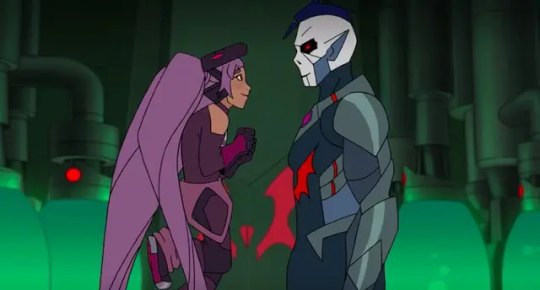
Entrapta truly is in my opinion just…PEAK when it comes to character-writing. She's great autism representation, and I also just love how morally grey she is when you think about it for a bit. Her moment of going “I don't know people, I know tech, so I thought I could help people by knowing tech” is very moving.
And Hordak makes for an interesting spin on a story of discovering your identity. I'll always be down for characters I can look at as a trans metaphor. “I am Hordak, and I defy your will” goes hard as hell.
Combined? Well, I love myself a pastel x goth ship. Hordak doesn't really know how to connect with people, and Entrapta, funnily enough cancels that out. She sees through a lot of his behaviour. Very steadily, they become two people wishing the absolute best for each other, two people who want to see each other rise above all that they have been through.
…
also obligatory Meta Knight and the Meta Knights mention, that guy and his crew BUILT A WARSHIP. Presumably a lot of the things that came with it too! When you think about it, that's insane!
#athy rambles#also shout out to the Dr Verit Lemuel Barlakoden (the artificer I'm playing rn) for radiating autism and loving men#Silly Game Time#she ra#she ra and the princesses of power#she ra entrapta#entraptdak#entrapta#hordak#entrapdak
13 notes
·
View notes
Text
My headcanon is that this is the origin of the term 'Force Captain'. Prime theoretically could manage the entire Galactic Horde, but let's be frank there'd be too much micromanaging going on for him to truly manage it, especially if he's not bluffing about the scale of his empire.
So when there's a situation large enough where it needs attention but not something that Prime wants to personally focus on, he needs to assign a semi-independent commander to a job and have them handle it on his behalf. Prime can still pop in, but at least now he only has to worry about one clone to get a full picture, and when Prime isn't busy with it that front said Force Captain has Prime's authority in matters. They're given their troops and can ask for more if the situation escalates, but otherwise they're left to their own devices to get the job done. When their task is complete and Prime doesn't need that micromanaging support, the title is revoked and they're back to normal.
Hordak was one such Force Captain and maybe even a successful one (if nothing else, he's capable of recognizing when his tactics are wasteful or failing and was able to change), but he didn't quite understand the nature of being a Force Captain or his perception of it had warped during his time on Etheria. It's likely that during the ceremony or moment that the title is revoked, that's when Prime noticed his defect and sent him to the vanguard to die and no longer be an 'imperfection', turning it into a moment of humiliation.
On Etheria, he repurposed the rank in his knockoff Horde to a similar goal and treated them the way he saw it - they're officers who can be trusted to lead a command, but do not necessarily lead a regiment day-to-day. Hence why Scorpia and Catra seem to have no command despite their rank: as Force Captains, they don't have a regiment that answers to them. They take command of whatever troops are necessary or delegated to the task, and are trusted to carry out Hordak's will independently, then the troops return to their normal commands or the reserves after the job is done. Unlike in the Galactic Horde, though, they keep the rank and are held in reserve for when they are needed again rather than it being stripped from them.
After all, Hordak acts the way he wishes Prime was... and is a far better person than Prime is.
right so we all know how, during his flashback scene, Hordak tells Entrapta he was Prime's "top general"
but then when we actually see the clones and how they operate they all seem to be equal, with no generals or any specific positions or jobs
im just wondering what we all think of this:
*as in, to help him feel as if Prime did care for him and would accept him back if he proved himself - it was solely the fault of his defect that he was cast aside and if he could prove that him being defective did not affect his capabilities then Prime would allow him back
93 notes
·
View notes
Text
"Are we just gonna ignore that?"
Mermista is, of course, referring to Hordak and Entrapta together at the end of the Finale. I think its an interesting question, and represents far more than a meta look at the ship of Entrapta and Hordak.
Fundamentally, She-Ra Princess of Powers (2018) has a drastically different view of what it means to be "moral" and what "punishing villains" mean. It does not necessarily hold every individual who does something evil responsible for their actions, instead, investigating the system that prompts this evil. I want to explore that concept primarily through the characters of Entrapta and Hordak.
Hordak (The Derivative of Pure Evil) Starting with Hordak because he's frankly a bit less nuanced than Entrapta, not unnunaced, just less. He's introduced as the leader of the Horde, passive himself, but frustrated with Shadow Weaver's lack of progress. As the leader of the Horde, all-commanding, responsible for the (at least) decades of devastation and death.
However, despite that, he is- at least later on -given sympathy by proxy of standing next to Prime. Sure, Hordak has tried to dominate a world for decades, Prime has ruled the Universe for hundreds of years-maybe even a milenia. Further, while Hordak rules from afar, delegating his violence to Shadow Weaver and Catra, Prime manipulates directly- robbing will and mocking any form of attempted dignity in his presence.
Note that when Hordak does attempt to be charismatic he mimics Prime, most likely intentionally. It is clear that the evil Hordak has shown is fundamentally deritive, and that creates some amount of distance between Hordak and his actions. Further, there is the-slight as it is- possibility that Hordak had-fundamentally- no choice but to do as Prime programmed him. I find this interpretation doubtful due to the existence of Wrong Hordak, but, in fairness- he was severely physically damaged immediately.
Regardless of your take on that, Hordak is shown sympathy by Entrapta. This is interesting, not because Entrapta "doesn't care about her friends" as some people try to argue, but because it clearly displays how Entrapta cares about her friends. Sidelining that for a moment, Hordak is a great example of systemic oppression at work- not just as a leader, but as a victim of it. He was created "flawed" and was cast out, having only known one thing- Prime and his conquest- he attempts to emulate it but can't, not totally.
In his mission he recruits people like Shadow Weaver, and encourages her when she creates people like Catra and Adora- no doubt- even ordering the creation of the program which creates child soldiers. Stripping them of their indviduality through uniform and loyalty, twisting collectivism to benefit one individual through the gathering and hording of resources. When we see Hordak interact with his empire its strictly toward his end or delegated to another party. He expects his soldiers to be an extension of himself in totality, obviously, as a result of him being a clone of Prime.
The fact that most of the antagonism for at least the earlier seasons is a result of Shadow Weaver should not be ignored. Despite explicitly ordering Shadow Weaver to stop focusing on Adora she continues to do so, she has the capability to summon Force Captains and order them against his wishes- even one he promoted himself! By his own creation, Shadow Weaver is able to push a system where she wants to go, thats because at this point SW is who controls it, not Hordak. Once Catra defeats and imprisons Shadow Weaver, she attempts to take her place- and then the focus switches from SW to Catra as the primary antagonist.
Hordak is, never really the "true" narrative antagonist of She-Ra, not really, instead he represents the impersonal ambitious and destructive system of oppression.
So why the hell does he let a short, genius, probably neurodivergent woman invade his sanctum and aid him with something he hasn't confided in his closest generals with?
Entrapta (Schrodinger's Scientist) Lets talk about Entrapta.
Entrapta begins fairly simply, as the typical "mad genius" archetype, even introduced in a stereotypically villainous way cinnematically- a silhouette on a canvas of forboding colors. Then, revealed to be, fairly short, and asymetrical design wise- with top heavy hair that supports her. Immediately cutting most of the threat from the introduction. Entrapta seems to embody that contradiction as we move forward. Simultanously focused on doing whatever she can to learn and experiment and still being so anchored to others.
Over and over, we see Entrapta convinced not necessarily by helping friends or stopping enemies, but by studying more and more technology. Ot at least, thats what seems to happen, I want to posit another explanation. Mostly, I want to focus on her decision to stay in the Horde, and I do think its a decision. While Catra does indeed manipulate Entrapta at least to an extent, is isn't using false information or to lure her to some forboding place. Catra feels- imo -empathetic toward Entrapta. Her friends who had claimed to care for her had left her, used her as a tool to accomplish their goals, thats something Catra can relate to.
While this perception isn't true, Entrapta seems to believe it, and is visibly disturbed by the relation. Quickly, Scorpia befriends Entrapta, and even Catra seems somewhat fond of Entrapta's company. Entrapta explores all sorts of situations, helps the Horde quite a bit, and even begins to befriend(?) Hordak? Why? Is it because she feels betrayed and whats vengeance? Is it because she doesn't care about whats right and whats wrong? I don't think so- I think Entrapta fails to see the system behind an individual, or maybe doesn't care for it. She's almost a mirror to Catra in that way.
However, where Catra thinks herself immune to the propaganda of the system just by knowing it, Entrapta seems unaware or unconcerned by the logical ends of her actions. In a way that seems to both contradict her focus on scientific rigidity and completely fit with how she was introduced: in the throws of experiment, and completely unprepared when the logical end of it backfired. It is both a strength and a weakness of the character- something I have to agree with user Gythyanki (https://www.tumblr.com/gythyanki) that She-Ra 2018 does quite well.
Humanizing Hordak (And Destroying the System) It is precisely due to Entrapta's unique perception of systems that she is able to befriend Hordak. Keep in mind, for his entire life, Hordak has only known conquest and using people as a means to their ends. Thats how Prime sees him, thats how Shadow Weaver sees him, thats even how Catra sees him. So- when this woman- who should be an enemy, who should be a prisoner- not provides aid to him when he thought no one else could, but doesn't just use him it makes perfect sense that he becomes fond of her.
And while Entrapta's decision to help a tyrannical dictator build a portal that could have ended the world was.... not good, in the end, if Hordak hadn't been turned at least to Entrapta's side, there's a chance Prime could have won. And really, thats sorta the point right? Its not that Hordak didn't do horrible things. Its not that Entrapta was right to build robots for Catra or help Hordak build a portal, but that, it was not wrong for Entrapta to extend compassion toward him. That the evil being done is not ultimately caused by the individual, not really, but by the larger system at play.
Once you elminate Hordak from his context as ruler of the Horde, what do you have? You have a "defective" clone who'll do anything to return to his "brother's" good graces, but has fundamentally failed him by becoming an individual. Hordak learns to have his own values and chooses the one that showed him kindness over the one that used him. So "Are we just gonna ignore that?" has an answer, no, we aren't. Because we've already dealt with the problem. Hordak's means of doing harm has been taken from him, and his motivation to do it similarly.
Fundamentally, what would killing Hordak accomplish here? I might even ask, what would punishig him accomplish? She-Ra Princess of Powers seems to refuse the traditional concept of punitive punishment, and instead focus on how people are actually effected. How was Catra and Adora affected by Shadow Weaver? How was Shadow Weaver affected by Hordak? How was Hordak affected by Prime? What sort of system perpetuated the harm these individuals did? And how do we stop it?
I can't claim to know what the objectively best moral framework is, but I do know, that I can agree with the idea that maybe people matter a bit more than vague notions of "justice" which harm more people than they actually help.
End Note I: I am NOT saying Entrapta and Hordak are justified in their actions, and I am also not saying that Hordak shouldn't probably have to do a lot of rebuilding. One more note: individualism isn't inherently a "bad" thing, but it can be weaponized to attack geniune collectivism used to aid people in securing resources, be wary of that sort of thinking.
End Note II: Just in case you were busy reading and didn't wanna open a new tab GO READ GYTHYANKI'S STUFF, I WILL FIND AND RANT ABOUT HOW GOOD IT IS IF YOU DON'T
30 notes
·
View notes
Note
Space Bats?
I've mostly left out stuff that was meta rather than fic, but this one got left in. It's me considering how Hordak's species descending from bats would work, what kind of bats they descended from for instance. Considering I don't know that much about bats it's probably not that helpful, but it was interesting for me to put together and gave me an excuse to wiki walk.
An excerpt:
Hordak’s failed clones notably have wings, making me think this is an ancestral trait like a human tail that should disappear in embryo. This leads me to suspect that Hordak’s ancestral species was six-limbed and batlike, possibly resembling Imp more closely than Hordak.
Hordak’s facial features are also distinctively batlike. Interestingly, the reason those traits, the large, leaf-shaped ears and flat nose, are so distinctive to bats is because they are needed for echolocation. Fruit bats have longer snouts and smaller ears, looking more similar to other mammals.
Most echolocating bats are small insectivores, however the False Vampire Bats (megadermatidae) are larger and some prey on small animals, birds and other bats. Some species are ambush predators, locating prey from roost with echolocation and then dropping to take them in a short flight. The ancestral species being ambush predators would fit with Horde Prime’s eyes, if you assume they are closer to the original eyes of the species and the pupilless, glowing eyes of the clones are artificial or modified. Other species are gleaning species, making short flights over the ground and snatching up what they find, or they combine both methods. The gleaning behaviour is one where it is perhaps more likely the wings would become vestigial in the absence of larger predators.
7 notes
·
View notes
Text
Part 2 of tonight's asks...

@superbdragoncollection-stuff It's probably not a romantic thing, but I reckon Bow and Wrong Hordak would get on pretty well socially. You know, when they're not trying to fight off an alien army.

@vampire-meta-knight Agreed, I think it's meant in that sort of way rather than anything sexual (because that way lies some pretty horrible realisations).

@etheriankid Nooo, now you've spoilt my grand finale where Adora's jacket jumps off her and beats Prime to a bloody pulp!

Just wait for the follow-up, "Devastating but I can't stop laughing"
39 notes
·
View notes
Text
It is also definitely ableism.
You can definitely see Catra as being mentally ill too - but she is still very, very capable to think and talk like a neurotypical, and the ways it does manifest are very easily understandable to neurotypicals.
That is not the case for Entrapta.
And Hordak is physically disabled, and while the show loves to understate this and then just erase it in the last season because oh we are so progressive, that is also not something you can explain away cutsyly.
Wrong Hordak is a bit harder to grasp, but I think here too it is that the kind of trauma he has is just not something neurotypicals experience, mixed with "if its not X bad it is not valid".
It is also, and I don't even know what to call that specific form of bigotry, this sense that trauma and mental health issues are only valid when the person experiencing them is attractive to them. Aka a able-bodied, thin, pretty much neurotypical passing lesbian teenage girl.
And don't even get me started on the raging ableism in pretty much all of the fandom except for the Entrapdak shippers (though I have to admit that the Shadow Weaver fans and Glimmadora shippers were at least lesser extreme and gross than the rest about it), and how the parts of the crew that weren't harassed by said puritanical bullies totally refused to acknowledge the problem.


I never understood why their trauma was treated as jokes when catra gets her trauma treatment with absolute seriousness.
Entrapta never confronted catra for betraying and shocking her, her time at beast island gets played for jokes.
Wrong hordak gets treated like a complete joke, his trauma treated as comedy then proper trauma.
Hordak trauma gets overshadowed and mocked when Catra took his crystal, the scene treats it like a badass moment when I see it as catra being ablest since hordak is a disabled character yet his trauma with his disability doesn’t fully get taken seriously and gets used against him so many times.
How is that fair? I love the show but that’s my biggest problem, the favoritism is so obvious in show and fandom.
145 notes
·
View notes